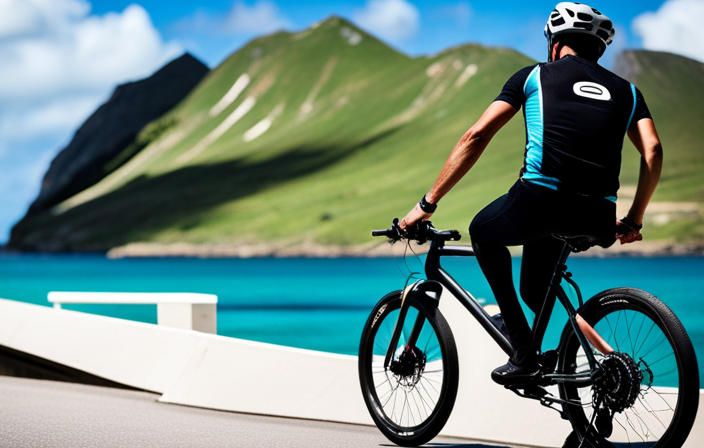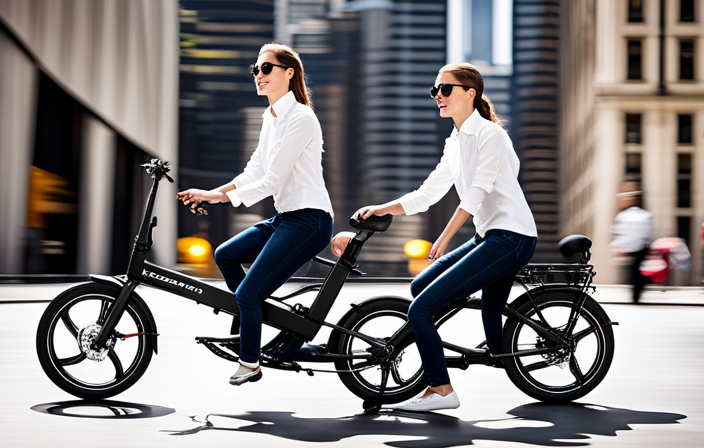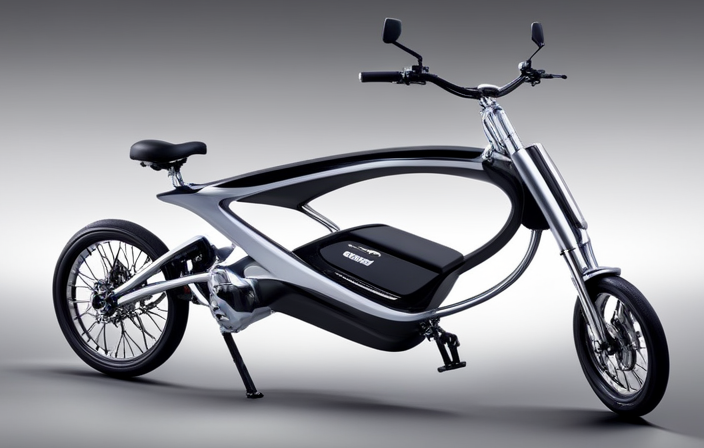As an avid cyclist, I’ve always been on the lookout for ways to enhance my riding experience.
One of the most significant advancements in recent years has been the introduction of lithium electric bike batteries. These powerful and efficient batteries have revolutionized the world of cycling, providing riders with a reliable source of energy for their electric bikes.
In this article, we’ll explore how to get the most out of these batteries, ensuring that you can enjoy longer rides and maximize your cycling performance.
Key Takeaways
- Proper charging practices, such as avoiding overcharging and deep discharges, can maximize battery life.
- Optimal battery storage and maintenance, including charging between 40% and 60%, regular inspection and cleaning, and using the right charger, ensures longevity.
- Optimizing battery efficiency through power settings, smart riding techniques, utilizing regenerative braking, and optimizing bike’s aerodynamics can conserve battery energy and increase range.
- Keeping the battery at the right temperature, avoiding overheating, and seeking professional assistance for maintenance and upgrades are essential for battery health and performance.
Understand the Basics of Lithium Electric Bike Batteries
To get the most out of your lithium electric bike batteries, you need to understand the basics. Lithium batteries have become the go-to choice for electric bikes due to their high energy density and long lifespan. Understanding how to properly charge and care for these batteries will ensure optimal performance and longevity.
The lifespan of a lithium battery is influenced by various factors. One of the most important aspects is charging. It is essential to follow the recommended charging best practices to maximize the battery’s life. Avoid overcharging or leaving the battery connected to the charger for an extended period. Overcharging can lead to excessive heat generation and shorten the battery’s lifespan.
Another crucial charging practice is to avoid deep discharges. Lithium batteries prefer to be charged before reaching a low state of charge. Regularly charge your battery when it reaches around 20-30% remaining capacity. This helps prevent the battery from entering a deep discharge state, which can be detrimental to its overall health.
By understanding the basics of lithium battery lifespan and following the recommended charging best practices, you can ensure that your electric bike batteries perform optimally for a longer period.
Now, let’s dive into the next section about properly charging and discharging your battery.
Properly Charge and Discharge Your Battery
Make sure you fully charge and discharge your battery to maximize its lifespan and performance. Proper charging techniques are essential for maintaining the health of your lithium electric bike battery. By avoiding overcharging and undercharging, you can ensure that your battery remains in good condition for longer periods.
To help you understand the importance of proper charging techniques, here is a table outlining the recommended charging parameters for lithium electric bike batteries:
| Charging Parameter | Range | Optimal Value |
|---|---|---|
| Charging Voltage | 4.2 – 4.3 volts per cell | 4.2 volts |
| Charging Current | 0.5 – 1.0 C | 0.8 C |
| Charging Temperature | 0 – 45 degrees Celsius | 25 degrees |
Following these guidelines will prevent overcharging, which can lead to battery degradation and reduced capacity. Similarly, avoiding undercharging will prevent damage to the battery and ensure optimal performance.
Optimize Power Settings for Efficiency
Optimizing power settings can greatly improve the efficiency of your battery. By implementing power saving strategies and effective battery management techniques, you can prolong the life of your lithium electric bike battery and ensure optimal performance.
One key strategy is to adjust the power settings on your bike to match your riding conditions. By reducing the power output when it’s not needed, you can conserve battery energy and extend your riding range. This can be done by using lower assistance levels or adjusting the throttle sensitivity. Additionally, it is important to monitor your battery usage and avoid excessive acceleration or heavy braking, as these actions can drain the battery more quickly.
Another effective power saving strategy is to turn off unnecessary features and functions on your electric bike. For example, disabling the bike’s built-in lights during the day or using the bike’s display sparingly can help conserve power. Additionally, reducing the brightness level of your bike’s display screen can also contribute to power savings.
Transition: In addition to optimizing power settings, it is crucial to keep your battery at the right temperature to maximize its performance and lifespan.
Keep Your Battery at the Right Temperature
Keeping your battery at the right temperature is essential for maximizing its performance and lifespan. Proper battery maintenance and temperature control are crucial factors in ensuring the longevity and efficiency of your lithium electric bike battery. Here are some important steps to follow:
-
Store your battery in a cool and dry place. Avoid exposing your battery to extreme temperatures, such as direct sunlight or freezing conditions. Keep your battery away from sources of heat, such as radiators or hot surfaces.
-
Charge your battery at the recommended temperature. Consult the manufacturer’s guidelines to determine the optimal temperature range for charging your battery. Avoid charging your battery in extremely hot or cold environments.
Avoid Overheating Your Battery
To prevent your battery from overheating, it’s important to monitor its temperature regularly and take necessary precautions. Overheating can lead to reduced battery life and potential safety hazards.
One way to avoid overcharging and excessive heat is by using a charger that is specifically designed for your lithium electric bike battery. These chargers are equipped with safety features such as automatic shut-off when the battery is fully charged.
It’s also crucial to avoid exposing your battery to extreme temperatures, both hot and cold. High temperatures can cause the battery to degrade faster, while extremely low temperatures can reduce its overall performance.
Additionally, it’s essential to prevent moisture damage by keeping your battery away from water or any other liquids. Moisture can seep into the battery and cause irreversible damage. Regularly inspect your battery for signs of moisture or corrosion and take immediate action if any issues are detected.
By following these guidelines and taking proper care of your battery, you can ensure its longevity and optimal performance.
Now, let’s move on to the next section: storing your battery properly.
Store Your Battery Properly
Now that we understand the importance of avoiding overheating our lithium electric bike batteries, let’s move on to another crucial aspect of battery care: proper storage methods.
Storing your battery correctly is essential to prolonging its lifespan and maintaining its performance. By following a battery maintenance checklist, you can ensure that your battery remains in optimal condition even when not in use.
To start, always store your battery in a cool, dry place away from direct sunlight and extreme temperatures. This helps prevent any potential damage caused by heat or cold. Additionally, make sure to store your battery in a well-ventilated area to minimize the risk of gas buildup.
When storing your battery, it is important to maintain an appropriate charge level. Ideally, store your battery at a charge level between 40% and 60%. This range helps balance the battery’s capacity without causing any stress or excessive discharge.
Furthermore, avoid storing your battery for extended periods without use. If you won’t be using your electric bike for an extended period, it is recommended to charge the battery to around 80% and then recharge it every three months to prevent capacity loss.
By following these proper storage methods and incorporating them into your battery maintenance checklist, you can ensure that your lithium electric bike battery remains in optimal condition.
Now, let’s move on to the next section, where we will discuss the importance of regularly inspecting and maintaining your battery.
Regularly Inspect and Maintain Your Battery
Regularly inspecting and maintaining your battery is crucial for ensuring its long-term performance and preventing any potential issues. By implementing regular maintenance practices, you can extend the lifespan of your battery and keep it running at its optimal capacity. Here are some key steps to follow when inspecting and maintaining your battery:
-
Visual Inspection: Start by visually inspecting the battery for any signs of damage or wear, such as cracks, leaks, or corrosion. If you notice any issues, it’s important to address them promptly.
-
Cleaning: Keeping your battery clean is essential for its proper functioning. Use a soft cloth or brush to remove any dirt or debris from the battery casing. Avoid using harsh chemicals that could damage the battery.
-
Note: Make sure to disconnect the battery from the power source before cleaning.
-
Terminal Cleaning: The battery terminals can accumulate dirt and corrosion over time, which can impede the flow of electricity. Use a mixture of baking soda and water to clean the terminals with a brush or cloth.
-
Pro tip: Apply a thin layer of petroleum jelly to the terminals after cleaning to prevent future corrosion.
Regular maintenance and inspection of your battery will help identify any potential issues and ensure its longevity.
Now, let’s move on to the next section where we will discuss the importance of using the right charger for your battery.
Use the Right Charger for Your Battery
Using the correct charger for your battery is essential in order to prevent damage and ensure optimal charging performance. When it comes to battery maintenance, using the right charger is crucial.
Lithium electric bike batteries require specific chargers that are designed to deliver the appropriate voltage and current. Using a charger that is not compatible with your battery can lead to overcharging, undercharging, or even damaging the battery cells.
To ensure that you use the right charger for your battery, it is important to check the specifications provided by the manufacturer. Look for chargers that are specifically designed for lithium batteries and match the voltage and current requirements of your battery.
Using a charger with the wrong specifications can result in inefficient charging, reduced battery life, and potential safety hazards. Additionally, it is important to follow the manufacturer’s instructions when it comes to charging your battery.
Avoid using generic chargers or chargers from other devices, as they may not provide the necessary safeguards for your battery. Stick to the recommended charger and charging process to maximize the lifespan and performance of your battery.
By using the right charger, you can ensure that your battery is charged properly and efficiently. This will help you avoid unnecessary wear and tear, extend the lifespan of your battery, and ultimately enjoy longer rides on your electric bike.
Now, let’s move on to the next section where we discuss how to avoid excessive weight on your bike.
Avoid Excessive Weight on Your Bike
To prevent unnecessary strain on your bike, it’s important to avoid adding excessive weight. Excessive weight can not only affect your riding experience but also cause damage to your electric bike’s components. One of the key aspects to consider when it comes to weight distribution on your bike is the battery. Lithium electric bike batteries can be quite heavy, so it’s crucial to distribute the weight evenly to prevent damage.
Here is a table illustrating the weight distribution guidelines for your electric bike:
| Component | Ideal Weight Distribution |
|---|---|
| Front Wheel | 40% of total weight |
| Rear Wheel | 60% of total weight |
| Battery | Centered and secured |
| Frame | Balanced and stable |
| Accessories | Minimized and lightweight |
Monitor Battery Health and Performance
After learning about the importance of avoiding excessive weight on your electric bike, let’s now shift our focus to another crucial aspect of maximizing the lifespan and efficiency of lithium electric bike batteries: monitoring battery health and performance.
By actively monitoring your battery’s condition, you can identify any potential issues early on and take the necessary steps to ensure optimal battery performance.
To help you understand the significance of battery maintenance and performance analysis, here are three key points to consider:
-
Regularly check battery voltage and capacity: Monitoring the voltage and capacity of your battery can provide valuable insights into its overall health and efficiency. By using a multimeter or a battery monitoring system, you can accurately measure the voltage and capacity of your battery and identify any abnormalities that may require attention.
-
Keep an eye on charging cycles: Lithium batteries have a limited number of charging cycles before their capacity starts to degrade. By keeping track of the number of charging cycles your battery has gone through, you can anticipate when it might be time to consider replacing it or take extra precautions to extend its lifespan.
-
Analyze battery performance using a dedicated app: Many electric bike manufacturers offer dedicated apps that allow you to monitor and analyze your battery’s performance. These apps provide valuable information such as remaining battery capacity, distance covered, and energy consumption, helping you make informed decisions about your riding habits and optimize battery usage.
By implementing these battery maintenance practices and regularly analyzing battery performance, you can ensure that your lithium electric bike battery operates at its best, maximizing its lifespan and efficiency.
Transitioning to the subsequent section about extending battery life with smart riding techniques, let’s explore how you can make the most of your lithium electric bike battery by adopting strategies that conserve energy and promote long-lasting battery performance.
Extend Battery Life with Smart Riding Techniques
By adopting smart riding techniques, you can significantly increase the lifespan and efficiency of your e-bike battery. Smart riding techniques refer to practices that optimize battery life and ensure that you get the most out of your electric bike.
One important technique is to avoid frequent and unnecessary acceleration and braking. Maintaining a steady speed and using the pedal-assist mode whenever possible reduces the strain on the battery and helps it last longer.
Additionally, planning your routes to minimize steep inclines and opting for flatter terrains can also help optimize battery life.
Another technique is to avoid extreme temperature conditions. Lithium batteries perform best within a specific temperature range, typically between 50°F to 86°F (10°C to 30°C). Riding in extremely hot or cold weather can decrease the battery’s efficiency and overall lifespan.
Lastly, it’s important to avoid overcharging the battery. Once it reaches its full charge, disconnect it from the charger to prevent unnecessary strain on the cells.
By implementing these smart riding techniques, you can maximize the performance and longevity of your e-bike battery.
To further extend the range of your e-bike and optimize battery life, consider upgrading to a higher capacity battery. This allows you to store more energy, providing a longer riding range and reducing the frequency of recharges.
Higher capacity batteries often have improved energy density, allowing for more power output without sacrificing overall battery life.
Upgrading to a higher capacity battery can be a worthwhile investment for those who regularly ride long distances or frequently use their e-bikes for commuting. It provides greater flexibility and peace of mind, knowing that you have enough power to reach your destination without worrying about running out of battery.
Before upgrading, make sure to check compatibility with your e-bike model and consult with a reputable e-bike dealer or manufacturer to ensure a seamless transition.
Consider Upgrading to a Higher Capacity Battery
Consider upgrading to a higher capacity battery for your e-bike to extend its range and optimize battery life. Upgrading to a higher capacity battery can offer several benefits, allowing you to go further on a single charge and enhancing the overall performance of your electric bike. Here are four reasons why you should consider alternative options and test battery performance:
-
Increased Range: A higher capacity battery will provide you with a longer range, allowing you to explore more without worrying about running out of power.
-
Improved Power Output: With a higher capacity battery, your e-bike will have a higher power output, giving you more torque and speed when you need it.
-
Longer Battery Life: Upgrading to a higher capacity battery can also improve the overall lifespan of your battery, reducing the need for frequent replacements.
-
Enhanced Performance: A higher capacity battery can significantly improve the performance of your e-bike, especially when climbing hills or tackling challenging terrains.
Take Advantage of Regenerative Braking
Taking advantage of regenerative braking can help extend the battery life of your e-bike. Regenerative braking is a technology that allows your e-bike to convert kinetic energy into electrical energy, which is then stored in the battery. When you apply the brakes, the motor acts as a generator, slowing down the bike and simultaneously charging the battery. This process not only reduces wear on your brake pads but also improves the overall efficiency of your e-bike.
By harnessing the power of regenerative braking, you can significantly increase the range of your e-bike. Instead of wasting energy through traditional braking, regenerative braking allows you to recover and store that energy for later use. This means that you can go further on a single charge and reduce the frequency at which you need to recharge your battery.
To optimize your e-bike’s aerodynamics, you can make a few adjustments. By reducing wind resistance, you can improve the efficiency of your e-bike and extend its battery life. One way to achieve this is by positioning your body in a more streamlined manner while riding. Additionally, you can consider adding accessories such as fenders, fairings, or even aero handlebars to further reduce drag. By incorporating these changes, you can maximize the efficiency of your e-bike and get the most out of your battery.
Optimize Your Bike’s Aerodynamics
Positioning your body in a more streamlined manner while riding can help optimize your e-bike’s aerodynamics. By reducing wind resistance, you can improve your bike’s overall performance and efficiency. Here are some key tips to achieve better aerodynamics and enhance your bike handling:
- Keep your body low and close to the handlebars to minimize wind drag.
- Tuck your elbows in and maintain a relaxed grip on the handlebars to reduce air turbulence.
- Bend your knees slightly and lean forward to create a more aerodynamic profile.
- Ensure that your bike is properly fitted to your body size and riding style for optimal comfort and control.
Implementing these techniques not only reduces wind resistance but also improves your bike handling. By positioning your body correctly, you can enhance stability, maneuverability, and overall control of your e-bike. This is especially important when riding at higher speeds or in challenging terrain.
Transition: To further enhance your e-bike riding experience, it is crucial to stay informed about the latest battery technology and innovations.
Stay Informed About the Latest Battery Technology and Innovations
To stay up-to-date with the latest advancements in battery technology for your e-bike, it’s important to regularly research and stay informed. Battery safety is a crucial aspect to consider when using lithium electric bike batteries. As technology continues to evolve, future advancements in battery design and materials promise improved performance and safety.
One area of focus for future advancements is enhancing the safety features of lithium electric bike batteries. Manufacturers are constantly working on developing batteries that are more resistant to overheating and overcharging. These advancements aim to minimize the risk of battery fires and explosions, providing users with a safer riding experience.
Another area of innovation is the development of batteries with increased energy density. Higher energy density means that the battery can store more power in a smaller and lighter package. This allows for longer rides and reduces the overall weight of the e-bike. Additionally, advancements in battery technology may also lead to faster charging times, enabling riders to spend less time waiting for their batteries to recharge.
Staying informed about the latest battery technology and innovations is crucial for e-bike riders. By keeping up with the latest developments, riders can ensure they are using the safest and most efficient battery technology available. Regularly researching and staying informed will not only improve the overall riding experience but also contribute to battery longevity and reliability.
Frequently Asked Questions
Can I use any charger to charge my lithium electric bike battery?
Yes, you can use any charger to charge your lithium electric bike battery as long as it is compatible. Charger compatibility is crucial to ensure safe and efficient charging.
It is recommended to use the charger provided by the manufacturer or a charger specifically designed for lithium batteries. Using an incompatible charger can damage the battery or lead to slower charging times.
Always check the charger specifications and follow the manufacturer’s guidelines to optimize charging time.
Is it necessary to monitor the battery health and performance regularly?
Yes, it’s necessary to monitor the battery health and performance regularly.
Battery monitoring is crucial for maintaining the optimal performance and prolonging the lifespan of lithium electric bike batteries.
Regularly checking the battery’s voltage, temperature, and charge level can help identify any issues or abnormalities.
Additionally, proper battery maintenance, such as avoiding extreme temperatures and fully charging and discharging the battery periodically, can help ensure its longevity and overall performance.
How can I optimize my bike’s aerodynamics to improve battery efficiency?
To optimize my bike’s aerodynamics and improve battery efficiency, I focus on my biking posture and reducing wind resistance.
While some may argue that biking posture doesn’t make a significant difference, the truth is that it plays a crucial role. By maintaining a streamlined position, with a slight forward lean, I minimize my body’s exposure to the wind and reduce drag.
This, in turn, allows the battery to work more efficiently and extend its overall lifespan.
What are some smart riding techniques that can help extend battery life?
Smart riding techniques can significantly extend battery life on lithium electric bike batteries. By maintaining a steady and consistent pace, avoiding sudden acceleration or braking, and utilizing regenerative braking whenever possible, energy consumption can be minimized.
Additionally, reducing wind resistance by adopting an aerodynamic riding position and using lower power assist levels can also contribute to longer battery life.
Proper battery maintenance, such as regular charging and avoiding extreme temperatures, is crucial for optimal performance and longevity.
How often should I consider upgrading to a higher capacity battery?
I should consider upgrading to a higher capacity battery based on the upgrading frequency and battery lifespan.
The upgrading frequency depends on how often I use my electric bike and how quickly the current battery’s capacity decreases. If I find myself needing to recharge more frequently or if the battery’s capacity diminishes significantly, it may be time to upgrade.
Additionally, considering the battery lifespan is important as higher capacity batteries usually have a longer lifespan.
Conclusion
In conclusion, to get the most out of your lithium electric bike batteries, it is crucial to implement proper charging and discharging techniques. This includes optimizing power settings for efficiency and maintaining the battery at the right temperature. Additionally, considering an upgrade to a higher capacity battery can greatly enhance performance.
Taking advantage of regenerative braking and optimizing your bike’s aerodynamics are also key factors in maximizing battery efficiency. These techniques can help extend the range of your electric bike and improve overall performance.
Lastly, staying informed about the latest battery technology and innovations is important. This will ensure that you stay ahead of the game and are aware of any advancements that can further enhance the performance of your lithium electric bike batteries.
Remember, being proactive and knowledgeable is the key to unlocking the full potential of your lithium electric bike batteries.









